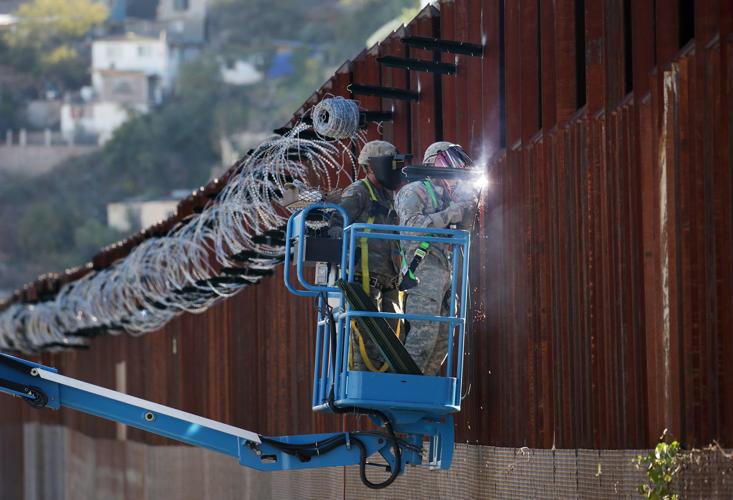The U.S.-Mexico border was practically silent on Sept. 11, 2001.
Late that morning, after the terrorist attacks in New York City, I rushed down to the DeConcini Port of Entry in Nogales. Hardly anybody was crossing, by foot or by car. We couldn’t see it that day, but the international line was quietly undergoing a transformation.
The U.S.-Mexico border had long been the focus of Americans’ anger and fear about illegal immigration, though Americans had mostly worried about Mexicans coming north for jobs. After 9/11, we started looking at it in a different light — as a possible terrorist entry point. The Border Patrol even made stopping terrorists its No. 1 mission, a priority that remains but is largely hypothetical.
Scott Stewart, vice president and terrorism expert at the private intelligence firm Stratfor, recalled for me Tuesday the nervous atmosphere of that time: “I remember just after 9/11 everybody talking about nuclear warheads being smuggled through Sinaloa Cartel tunnels across the border.”
Since then, the fear of cross-Mexican-border terrorism has proven irresistible. As recently as last week, the Trump administration was touting wildly exaggerated figures of possible terrorists caught at the border, using them as a reason for funding the border barrier President Trump wants.
The truth is, we do have a terrorism problem, but it is almost entirely internally generated, by citizens, permanent residents and visa holders living in the USA.
Illegal border-crossers have committed all sorts of crimes, up to and including murder, but there’s been hardly any evidence of terrorist acts committed in the United States by people who crossed the U.S.-Mexico border, either illegally between the ports of entry or at the ports.
The data on terrorist acts in America tells us that, but so do the most penetrating public efforts to find terrorists who crossed the border. Todd Bensman has been a pioneer of the practice of looking for these terrorists. Bensman, a former reporter and a fellow for the immigration-restrictionist group Center for Immigration Studies, published in November a review of all the suspected terrorists known to have crossed the Mexican border, legally or illegally, since 2001.
There were 15, less than one per year, and none of them committed an act of terrorism in the United States. They were largely people with suspected affiliations to terrorist groups or networks, not people known to have committed terrorism.
One of the typical men Bensman listed is an “unnamed Sri Lankan national.” Border Patrol agents apprehended him near McAllen, Texas, in March 2012. He acknowledged having been a member of the Tamil Tigers, a designated foreign-terrorist organization, and admitted he was crossing into the United States to go to Canada. Though the unnamed man had been a member of this group, Bensman published no evidence he came to North America to commit terrorism.
A more direct threat, among Bensman’s list of 15, came from Mohammad Ahmad Dakane. He entered the country legally at a Brownsville, Texas, port of entry in March 2008 and requested asylum. Later, a FBI terrorism investigation revealed that he had been a member of a U.S.-designated terrorist group al-Ittihad al-Islamiya. Dakane had worked in South America facilitating the migration of other Somalis before trying to cross himself. He was convicted of asylum fraud, but the government’s sentencing memorandum showed no evidence he participated in terrorist attacks.
The only person on Bensman’s list of 15 who actually committed an act of violence is Somali Abdulahi Sharif. He entered the United States in July 2011 at San Ysidro, California, and was ordered deported in September of that year. But at that time, the United States was not deporting people to Somalia, so he was released. He crossed into Canada and was given refugee status in 2012. He moved to Edmonton, Alberta, and his mental state deteriorated while he also expressed support for Islamist groups, the Edmonton Journal reported. On Sept. 30, 2017, he went on a vehicular rampage, hitting five pedestrians with two different vehicles, but fortunately killing no one.
That’s the one person we know for sure crossed the U.S.-Mexico border, though he did it at a port of entry, and committed terroristic violence. And it was in Canada.
Having covered the idea of terrorists crossing the border before, I’ve long thought that looking for terrorists among people who crossed the border is the wrong way to approach the issue. It leads you to too many borderline cases like the 15 in Bensman’s list (14 if you don’t count Sharif) and leads you to wild exaggeration like the one made by White House spokeswoman Sarah Huckabee Sanders last week:
“Last year alone there were nearly 4,000 known or suspected terrorists that CBP picked up that came across our southern border,” she said.
The truth was, 41 people on the terrorist watch list were encountered at the U.S.-Mexico border, NBC News reported, and 35 of them were U.S. citizens or permanent residents coming into the country legally. Only six were foreign. There is no public allegation that any of them actually committed terrorism.
“To say that there’s a crisis of terrorists storming the border is ridiculous,” Stewart said. “There is a threat there, but it’s very limited.”
The fact is, if you look at terrorism in America through the other end of the telescope — by looking at real acts of terrorism committed in the United States — you get a much more accurate picture of the role of people crossing the southern border. Their role is practically nil.
On Monday and Tuesday, I began a trip through the University of Maryland’s massive Global Terrorism Database, looking at terrorist acts committed in the United States. It is a fantastic database for this type of exercise because it’s so broad, including acts not just of clear political violence, but also racial and religious hate crimes and even sabotage of equipment. Even if you’re not 100 percent sure it’s terrorism, it will be in the database.
I downloaded 10 years of data, but so far have only made it through the latest year available, 2017. The results: Of 37 people convicted or accused of terrorist acts that year, none were in the country illegally. Only four were non-citizens. None crossed the border from Mexico. Only one crossed a border at all: Amor Ftouhi, a Canadian citizen, drove from Montreal to Michigan, screamed about “infidels” committing violence in the Middle East and attacked an airport security guard in Flint, Michigan, stabbing him to death.
The majority, 20 of the 37 known perpetrators, committed racially motivated acts that people call “hate crimes” as often as they call them “terrorism.” Those are people like Sean Urbanski, a white University of Maryland student accused of stabbing to death a black Army lieutenant and Bowie State University student, Richard Collins III, in an unprovoked racist attack at a bus stop.
The second-largest group, eight total including Ftouhi, committed Islamist terrorism. Sayfullo Saipov, for example, was a recipient of a diversity visa from Uzbekistan. He drove a rented pickup truck into pedestrians in Manhattan on Halloween day, Oct. 31, 2017, killing eight people.
The next-largest group of attackers, overlapping with the racists, were anti-Muslim and anti-immigrant attackers. Adam Purinton, for example, told two patrons at a bar in Olathe, Kansas, to “get out of my country” on Feb. 22, 2017. After being ejected, he returned and shot dead the two men, who were from India, not Iran as he had thought.
I’ll keep going down through the additional years in the terrorism database, taking what I think is the better approach to documenting terrorists who crossed the border — looking at those who committed terrorist acts and seeing if they crossed the Mexican border to get here.
But the information available since that transforming day in 2001 has shown that if you’re worried about terrorism, the U.S.-Mexico border is the wrong place to focus. People who are already here, American citizens and legal residents, we are our own terrorist problem.





